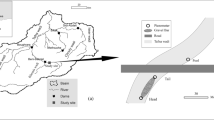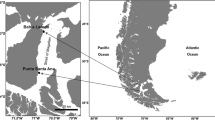Abstract
The topography of the Sado estuary, the second largest of Portugal, comprises the outer estuary inside the entrance channel and the inner estuary, on the inward side of which begins the tidal mudflats. The outer estuary subtidal area covers approximately 70 km2 and presents a series of longitudinal intertidal sandbanks, separating a northern and a southern channel.
A benthic survey was undertaken in the outer estuary during June 1986, in which superficial sediments and macrofauna were sampled at 133 locations. The environmental variables measured in the superficial sediments were the temperature, the granulometric structure, the silt, sand and the gravel content, and the total organic matter content. The primary macrofauna biological variables studied were the species composition, abundance and biomass, calculated on wet, dry and ash-free dry weight.
The granulometry and the organic content of superficial sediments agreed with the transient and the residual currents velocity field, simulated in a 2-D hydrodynamic model previously elaborated for the outer estuary. The northern channel superficial sediments showed higher silt and total organic matter content, while the model also suggested lower transient and residual velocities, water flow and shear stress in this channel.
The distribution patterns of the subtidal macrofauna were separated into two main groups of species, one comprising taxa essentially settled near the estuarine mouth and the other inwards. Biological primary variables also showed consistent patterns, comparable to other Portuguese estuaries. The major subtidal benthic biotopes were obtained through classification analysis and related to the prevailing hydrophysical and sedimentary conditions in the outer estuary.
Similar content being viewed by others
References
BORDALO COSTA, M.M. and M.C. PENEDA, 1989. Heavy metal detection in the sediment — water components of the Sado estuary by multielemental analysis. Environ. Technol. Lett., 213: 697–706.
BILYARD, G.R., 1987. The value of benthic infauna in marine pollution monitoring studies. Mar. Pollut. Bull., 18: 581–585.
BRYAN, G.W. and P.E. GIBBS, 1987. Polychaetes as indicators of heavy-metal availability in marine deposits. In: J. M. Capuzzo and D. R. Kester, Eds., Oceanic processes in marine pollution. Biological Processes and Wastes in the Ocean. Robert E. Krieger Publ. Co. Malabar, Vol. 1: 37–49.
BUHR, K.-J. and J.E. WINTER, 1977. Distribution and maintenance of a Lanice conchilega association in the Weser estuary (FRG), with special reference to the suspension feeding behaviour of Lanice conchilega. In: B. F. Keegan, P. Ó'Ceidigh and P. J. S. Boaden, Eds., Biology of Benthic Organisms. 11th Eur. Mar. Biol. Symp., Galway, 5–11 Oct. 1976: 101–113.
BYERS, S.C., E.L. MILLS and L. STEWART, 1978. A comparison of methods of determining organic carbon in marine sediments, with suggestions for a standard method. Hydrobiologia, 58: 43–47.
CASTRO, O. and C. VALE, 1991. Distribuição de PCB e DDT nos sedimentos do estuário do Sado. Resumos do Seminário Alterações Ambientais e Repercussões no Biota, Lisboa, 6–7 Maio, 1991: 5.
CATARINO, J., F. DUARTE, F. RALHA, S. KARMALI, M. BORDALO COSTA and L. HALL, 1989a. Caracterização das águas residuais da Propam — Consórcio Português de Panificação. LNETI report, 20 pp.
CATARINO, J., F. DUARTE, F. RALHA, S. KARMALI, M. BORDALO COSTA and L. HALL, 1989b. Caracterização das águas residuais da Inapa — Indústria Nacional de Papéis. LNETI report, 16 pp.
CATARINO, J., F. DUARTE, F. RALHA, S. KARMALI, M. BORDALO COSTA and L. HALL, 1989c. Caracterização das águas residuais da Portucel — Centro fabril de Setúbal. LNETI report. 23 pp.
CATARINO, J., F. DUARTE, F. RALHA, S. KARMALI, M. BORDALO COSTA and L. HALL, 1989d. Caracterização das águas residuais da SAPEC. LNETI report, 21 pp.
CATARINO, J., F. DUARTE, F. RALHA, S. KARMALI, M. BORDALO COSTA and L. HALL, 1989e. Caracterização das águas residuais da Fábrica de óleos vegetais de Sta Catarina. LNETI report, 19 pp.
CATARINO, J., F. DUARTE, F. RALHA, S. KARMALI, M. BORDALO COSTA and L. HALL, 1989f. Caracterização das águas residuais da cidade de Setúbal veiculadas pela Ribeira do Livramento. LNETI report, 18 pp.
CATARINO, J., F. DUARTE, F. RALHA, S. KARMALI, M. BORDALO COSTA and L. HALL, 1989g. Caracterização das águas residuais do Matadouro de Setúbal. LNETI report, 22 pp.
CURRÁS, A. and J. MORA, 1991. Comunidades bentonicas de la ria del Eo (Galicia-Asturias, NW España). Cah. Biol. Mar., 32: 57–81.
DOEGLAS, D.J., 1968. Grain-size indices, classification and environment. Sedimentology, 10: 83–100.
FAUCHALD, K. and P. JUMARS, 1979. The diet of worms: a study of polychaete feeding guilds. Oceanogr. Mar. Biol. Ann. Rev. 17: 191–284.
FERREIRA, J.N.R. and R.J.J. NEVES, 1987. Modelo matemático dos estuário do Sado. Extensão à plataforma adjacente. I. S. T. report: 141 pp.
GAUCH, H.G., Jr., 1982. Multivariate Analysis in Community Ecology. Cambridge University Press, x+298 pp.
GRAY, J.S., 1981. The Ecology of Marine Sediments. An introduction to the structure and function of benthic communities. Cambridge University Press, Cambridge, xi+185pp.
HILL, M.O., 1979. TWINSPAN — A FORTRAN Program for Arranging Multivariate Data in an Ordered Two-way Table by Classification of the the Individuals and Attributes. Ithaca, N.Y., Cornell University, 48pp.
HILL, M.O., R.G.H. BUNCE and M.W. SHAW, 1975. Indicator species analysis, a divisive polythetic method of classification and its application to a survey of native pinewoods in Scotland. J. of Ecol., 63: 597–613.
HILY, C., 1984. Variabilité de la macrofaune benthique dans les milieux hyper-trophiques de la rade de Brest. Thèse Docteur Ès-Sciences, Univ. Bretagne Occidentale. Vol. I: 359 pp, Vol. II: 337 pp.
HILY, C., H. LE BRIS and M. GLéMAREC, 1986. Impacts biologiques des emissaires urbains sur les ecosystèmes benthiques. Océanis, 12: 419–426.
HOARE, R. and E.H. WILSON, 1977. Observations on the behaviour and distribution ofVirgularia mirabilis O. F. Müller (Coelenterata: Pennatulacea) in Holyhead harbour, Anglesey. In: B. F. Keegan, P. Ó'Ceidigh and P. J. S. Boaden, Eds., Biology of Benthic Organisms. 11th Eur. Mar. Biol. Symp., Galway, 5–11 Oct. 1976: 329–337.
KRISTENSEN, E. and F.Ø. ANDERSON, 1987. Determination of organic carbon in marine sediments: a comparison of two CHN-analyser methods. J. Exp. Mar. Biol. Ecol., 109: 15–23.
KRUMBEIN, W.C., 1934. Size frequency distribution of sediments. J. Sediment. Petrol., 4: 65–77.
LÓPEZ-JAMAR, E., 1982. Distribución espacial de las comunidades bentónicas infaunales de la ría de Arosa. Bol. Inst. Esp Oceanog., 7: 255–268.
LÓPEZ-JAMAR, E. and J. MEJUTO, 1986. Evolución temporal de cuatro comunidades infaunales submareales de las Rías de Arosa y Muros. Resultados preliminares. Bol. Inst. Esp. Oceanog., 3: 95–110.
NEVES, R.J.J., 1985a. Étude expérimentale et modélisation mathématique des circulations transitoire et résiduelle dans l'estuarie du Sado. Thesis ‘Docteur en Sciences Appliquées’, Univ. Liège, Belgium: 271 pp.
NEVES, R.J.J., 1985b. Bidimensional model for residual circulation in coastal zones: application to the Sado estuary. Annales Geophysicae, 3: 465–472.
PEARSON, T.H. and R. ROSENBERG, 1978. Macrobenthic succession in relation to organic enrichment and pollution of the marine environment. Oceanogr. Mar. Biol. Ann. Rev. 16: 229–311.
PÉRÈS, J.M., 1967. The Mediterranean benthos. Oceanogr. Mar. Biol. Ann. Rev., 5: 449–533.
PICADO, A.M., 1991. Responses metaboliques d'invertebres marins aux pollutions. Cas particulier de la charge energetique adenylique. Thèse pour l'obtention du diplôme de l'Ecole d'Hautes Études, Paris, 105 pp.
PIELOU, E.C., 1966. The measurement of diversity in different types of biological collections. J. Theor. Biol. 13: 131–144.
QUINTINO, V., 1988. Structure et cinétique comparées des communautés de macrofaune benthique de deux systèmes lagunaires de la côte ouest du Portugal: Obidos et Albufeira. Thèse de Doctorat, Oceanologie Biologique, Université Paris 6: 1–333.
QUINTINO, V., A.M. RODRIGUES and F. GENTIL, 1989. Assessment of benthic communities in the lagoon of Obidos, western coast of Portugal. In: J. D. Ros, Ed., Topics in Marine Biology. 22nd Eur. Mar. Biol. Symp., Barcelona, Barcelona, 17–22 Aug. Scient. Mar., 53: 645–654.
REES, H.L., D.C. MOORE, T.H. PEARSON, M. ELLIOTT, M. SERVILE, J. POMFRET and D. JOHNSON, 1990. Procedures for the monitoring of Marine Benthic Communities at UK Sewage Sludge Disposal Sites. Dep. Agriculture and Fisheries for Scotland. Scottish Fisheries Information Pamphlet, 18: 1–79.
RETIÈRE, C., 1979. Contribution à la connaissance des peuplements benthiques du golfe Normanno-Breton. Thèse D'État, Univ. Rennes: 431 pp.
RODRIGUES, A.M., 1992. Environmental status of a multiple use estuary, through the analysis of benthic communities: the Sado Estuary, Portugal. Ph. D. Thesis, Univ. Stirling, January 1992: vii+364 pp.
RODRIGUES, A.M. and V. QUINTINO, 1988. Avaliação do efeito dos efluentes das indústrias de pasta de papel Soporcel e Celbi sobre a macrofauna bentónica do meio receptor. In: C. Borrego, I. Fernandes, A.R. Pires and A. Samagaio, Eds., Actas da 1a Conf. Nacional sobre a Qualidade do Ambiente, Aveiro, 22–24 Feb. 1988, Vol. 1: 250–262.
SHANNON, C.E. and W. WEAVER, 1963. The Mathematical Theory of Communication. University of Illionois Press, Urbana Illinois: 117pp.
TER BRAAK, C.J.F., 1986. Canonical correspondence analysis: a new eigenvector technique for multivariate direct gradient analysis. Ecology, 67: 1167–1179.
TER BRAAK, C.J.F., 1990. CANOCO, Version 3.11. Update notes. Agricultural Mathematics Group, Wageningen. (Unpubl. report): 35 pp.
TRASK, P.D., 1930. Mechanical analysis of sediments by centrifuge. Econ. Geol., 25: 581–599.
TYLER, P.A. and S.E. SHACKLEY, 1980. The benthic ecology of linear sandbanks: a modified Spisula sub-community. In: M. B. Collinset al., Eds., Industrial Embayments and their Environmental Problems. Pergamon Press: 539–554.
VANOSMAEL, C., K.A. WILLEMS, D. CLAEYS, M. VINCX and C. HEIP, 1982. Macrobenthos of a sublittoral sandbank in the Southern Bight of the North Sea. J. Mar. Biol. Ass. U. K., 62: 521–534.
VALE, C. and B. SUNDBY, 1982. A survey of the elemental composition of bottom sediments in the Sado estuary. Proc. of Actual problems of oceanography in Portugal. JNICT, Lisbon: 189–200.
VAN TONGEREN, O.F.R., 1987. Cluster analysis. In: R.H.G. Jongman, C.J.F. ter Braak and O.F.R. van Tongeren, Eds., Data Analysis in Community and Landscape Ecology. Pudoc Wageningen,: 174–212.
WARWICK, R.M., 1988a. Effects on community structure of a pollutant gradient — introduction. Mar. Ecol. Prog. Ser., 46: 149.
WARWICK, R.M., 1988b. Effects on community structure of a pollutant gradient — summary. Mar. Ecol. Prog. Ser., 46: 207–211.
WITHERS, R.G. and C.H. THORP, 1978. The macrobenthos inhabiting in Langstone Harbour, Hampshire. J. Nat. Hist., 12: 445–455.
WOLFF, W.J., 1973. The estuary as a habitat: an analysis of data on the soft bottom macrofauna of the estuarine area of the rivers Rhine. Meuse and Scheldt. Zool. Verhandel. Leiden, 126: 1–242.
Author information
Authors and Affiliations
Rights and permissions
About this article
Cite this article
Rodrigues, A.M.J., Quintino, V.M.S. Horizontal biosedimentary gradients across the Sado estuary, W. Portugal. Netherlands Journal of Aquatic Ecology 27, 449–464 (1993). https://doi.org/10.1007/BF02334806
Issue Date:
DOI: https://doi.org/10.1007/BF02334806




